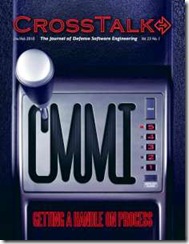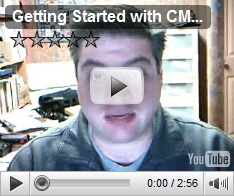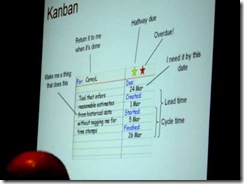 10.
10. Four months ago you couldn't spell "CMMI".
9. No one in your organization has ever had any training of any kind whatsoever in CMMI, appraisal planning, or process improvement.
8. You haven't worked with anyone (in-house or hired) who knows what they're doing with CMMI.
7. Price-shopping for lead appraisers seems like a good idea. Kind-a like price shopping for a heart-surgeon.
6. After months of work, you switch from one constellation to another and think your appraisal is still on schedule (see #9 and #8). Kind-a like switching your team from field hockey to ice hockey mid-season.
5. Your CEO is petulant about the delay of your appraisal yet has no idea that your actual process performance is in the toilet.
4. You've waited until it's time to start planning for your SCAMPI to start looking for a consultant to help you implement CMMI in an "agile" way.
3. The only people you're sending to
Introduction to CMMI are the ones you plan to have on the appraisal. You have no back-up plan if they can't make it to training and/or to the appraisal. Class isn't for another month, and, they're the same ones who've been working on your processes for the past several months, but until now, see #9 and #8.
2. You haven't qualified the people in #3 with your lead appraiser (which you haven't hired yet + see #9 and #8), you haven't qualified the projects to be appraised with your lead appraiser (which you haven't hired yet + see #9 and #8), and nonetheless, you have established a level of effort for the appraisal despite all of the above.
And,
The Number One Clue You're
NOT Ready for a SCAMPI:
1. After months of work, you still don't see there's a fundamental flaw in committing to or expecting others to commit to (including your
appraiser no less!) a firm-fixed price contract without knowing the requirements.
I wish the above list of clues were tongue-in-cheek.
Sadly, it's not. There is, nonetheless, plenty of fiction in it:
- The order of the list is mostly arbitrary.
- The list is not scientific.
- The list really should be longer. A lot longer.
- These clues are just from my experience alone, and doesn't account for anyone else's, so it's pretty idiosyncratic.
While in many cases, any one of the items in the list of clues could easily sabotage an organization's process improvement effort (let alone an appraisal), one thing that makes it especially troubling is the preponderance with which I encounter a single organization exhibiting most or all of these clues! And yet, such organizations think they actually
can dictate to their lead appraiser the terms and conditions and the readiness of their organization to be appraised!
I tried to limit the clues to only things you could pick-up from a conversation -- even if you know nothing about CMMI or the SCAMPI appraisal method. I tried to keep the clues to things that don't have to do with CMMI itself or process stuff as a general theory. If I had included such items, I would add:
- You don't know that to do a SCAMPI you actually have to have used the processes on actual projects.
- You don't realize that there's more to CMMI than the names of the process areas.
- You don't realize that the generic goals and practices aren't just "extra information".
- You don't know that it's still the lead appraiser's responsibility to approve the people and the projects to be in the appraisal.
If you look at some of the other behaviors of organizations not really ready for a SCAMPI, you'll find that they continue to:
- accept more work than they can handle,
- be unpredictable in what they will deliver and when,
- measure little other than billable hours, and
- have no insight into where their defects come from.
Despite the condition in which many organizations may have artifacts for an appraisal, they have seen no intrinsic benefits to their new set of processes. They've been just "chasing a level", which results in lots of work for no real benefit. You can guarantee these organizations will drop their processes shortly after the appraisal.
Really, what these clues point to is the dreadful lack of realization that first and foremost, process improvement requires the right
culture for
process excellence. The above list points to a fundamental absence of the culture for process excellence. What people don't realize (especially in the USA), is that process
improvement is a total JOKE for companies with the right culture of process excellence. If people want the truly idiot-proof, guaranteed, easy path to just about any CMMI Maturity Level, they would need to go no further than to foster a culture of process excellence, then whatever they did from that point forward would likely cause just about every practice in CMMI to form on its own. In other words, these clues
aren't about
process, they're about
culture and
leadership. You don't have to know anything about CMMI to pick up clues about culture and leadership.
One of the failures of CMMI is that it fails to press the basic importance of culture and leadership for process improvement. It fails to communicate in no uncertain terms that an absence of the right culture (and what that looks like) and the absence of leadership (and how that shows up) will lead to a failure in process improvement -- CMMI or otherwise. I'm not blaming CMMI for not including this information in the text, because much of it
is there. What I'm saying is that despite what is there about the importance of culture and leadership, most CMMI users fail to grasp these important points. The text, therefore, fails to communicate this in a way that people will pay attention.

CMMI should come with a warning similar to,
"Don't Try This At Home!" or
"Use Only as Directed!", or
"Check with a Qualified Professional Before Beginning Any Process Improvement Program", or
"You Must Be *This* Tall to Use this Book". Or simply,
"Danger Ahead!".
Something to get people's attention and direct them to some of the fundamentals of any improvement program.
This accusation is not just leveled at garden-variety CMMI adopters. Often, they're the hapless "stuckees" forced to "make CMMI happen" against all odds. At least there's ample reason to be sympathetic to their plight. What's inexcusable are the too-many consultants, instructors and appraisers who are willing to ignore these fundamental requirements-for-success and who are unwilling or unable to posture with prospects and clients in such a way as to impart the importance of culture and leadership to success with CMMI. So, that translates to a pathetic statement about the consulting abilities (and possibly the ethics) of too many people who take money to work with others on CMMI.
Sorry for the rant. But people need to be warned. Attempting a CMMI effort without the requisite culture and leadership attitude may yield a short-term appraisal rating, but will ultimately lead to medium and long-term failure. *THAT* I can guarantee.
This is why I'm such an advocate for agile methods. Agile methods impart some of the basic needs for long-term process success. And, it imparts them at a level of abstraction usable by people who aren't process experts, yet establishes many of the appropriate culture and leadership traits that so many CMMI-only efforts fail to recognize. Agile values, methods, and practices empower their teams, cause leadership to eliminate obstacles, value the input of customers and practitioners alike, values learning, develops multi-disciplined teams, and most importantly (as far as processes are concerned) promotes lean thinking. While Agile ideas may not change leadership and culture over night, they contain many of the right activities that can eventually win over those whose hearts and minds need winning over. And, with the appropriate use of CMMI, agile ideas can kick-start the motion and direction needed for long-term and ongoing improvement.
I'll be writing more about why CMMI and Agile need each other for a while.
Stay tuned.
Labels: Culture, Leadership, lean, SCAMPI




 San Jase, CA. Actually there won't, unfortunately, be much to report today as I was side-tracked from all but one session. The session I attended was an experience report from a lead appraiser working with a company whose total size was all of 12 individuals. In fact, they were a distributed workforce with no central offices. Everyone worked from home. This was a report on how they achieved CMMI ML3. The company itself had very impressive results made possible by very impressive people and attitudes. Let's get one (or two) things straight immediately: (1) they really truly were ML3, no corners cut, they really truly did the work of defining, managing and using their processes, (2) they did NOT need CMMI to be disciplined -- to a person they were highly skilled, highly technical, supremely professional, absolutely committed their work and company, incredibly laid-back, and deadly serious about NOT causing themselves work that was not fun and benefit the work and company.
San Jase, CA. Actually there won't, unfortunately, be much to report today as I was side-tracked from all but one session. The session I attended was an experience report from a lead appraiser working with a company whose total size was all of 12 individuals. In fact, they were a distributed workforce with no central offices. Everyone worked from home. This was a report on how they achieved CMMI ML3. The company itself had very impressive results made possible by very impressive people and attitudes. Let's get one (or two) things straight immediately: (1) they really truly were ML3, no corners cut, they really truly did the work of defining, managing and using their processes, (2) they did NOT need CMMI to be disciplined -- to a person they were highly skilled, highly technical, supremely professional, absolutely committed their work and company, incredibly laid-back, and deadly serious about NOT causing themselves work that was not fun and benefit the work and company.


-200.jpg)
